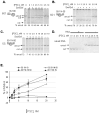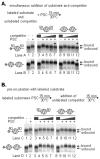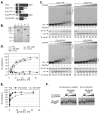Inhibition of chromatin remodeling by polycomb group protein posterior sex combs is mechanistically distinct from nucleosome binding
- PMID: 20873869
- PMCID: PMC3037448
- DOI: 10.1021/bi100532a
Inhibition of chromatin remodeling by polycomb group protein posterior sex combs is mechanistically distinct from nucleosome binding
Abstract
Polycomb Group (PcG) proteins are essential regulators of development that maintain gene silencing in Drosophila and mammals through alterations of chromatin structure. One key PcG protein, Posterior Sex Combs (PSC), is part of at least two complexes: Polycomb Repressive Complex 1 (PRC1) and dRING-Associated Factors (dRAF). PRC1-class complexes compact chromatin and inhibit chromatin remodeling, while dRAF has E3 ligase activity for ubiquitylation of histone H2A; activities of both complexes can inhibit transcription. The noncovalent effects of PRC1-class complexes on chromatin can be recapitulated by PSC alone, and the region of PSC required for these activities is essential for PSC function in vivo. To understand how PSC interacts with chromatin to exert its repressive effects, we compared the ability of PSC to bind to and inhibit remodeling of various nucleosomal templates and determined which regions of PSC are required for mononucleosome binding and inhibition of chromatin remodeling. We find that PSC binds mononucleosome templates but inhibits their remodeling poorly. Addition of linker DNA to mononucleosomes allows their remodeling to be inhibited, although higher concentrations of PSC are required than for inhibition of multinucleosome templates. The C-terminal region of PSC (amino acids 456−1603) is important for inhibition of chromatin remodeling, and we identified amino acids 456−909 as being sufficient for stable nucleosome binding but not for inhibition of chromatin remodeling. Our data suggest distinct mechanistic steps between nucleosome binding and inhibition of chromatin remodeling.
Figures






Similar articles
-
Chromatin modification by PSC occurs at one PSC per nucleosome and does not require the acidic patch of histone H2A.PLoS One. 2012;7(10):e47162. doi: 10.1371/journal.pone.0047162. Epub 2012 Oct 11. PLoS One. 2012. PMID: 23071745 Free PMC article.
-
DNA Binding Reorganizes the Intrinsically Disordered C-Terminal Region of PSC in Drosophila PRC1.J Mol Biol. 2020 Aug 7;432(17):4856-4871. doi: 10.1016/j.jmb.2020.07.002. Epub 2020 Jul 3. J Mol Biol. 2020. PMID: 32628956 Free PMC article.
-
The role of the histone H2A ubiquitinase Sce in Polycomb repression.Development. 2012 Jan;139(1):117-27. doi: 10.1242/dev.074450. Epub 2011 Nov 17. Development. 2012. PMID: 22096074 Free PMC article.
-
Chromatin regulation: how complex does it get?Epigenetics. 2014 Nov;9(11):1485-95. doi: 10.4161/15592294.2014.971580. Epigenetics. 2014. PMID: 25482055 Free PMC article. Review.
-
Polycomb response elements and targeting of Polycomb group proteins in Drosophila.Curr Opin Genet Dev. 2006 Oct;16(5):476-84. doi: 10.1016/j.gde.2006.08.005. Epub 2006 Aug 17. Curr Opin Genet Dev. 2006. PMID: 16914306 Review.
Cited by
-
Compaction of chromatin by diverse Polycomb group proteins requires localized regions of high charge.Genes Dev. 2011 Oct 15;25(20):2210-21. doi: 10.1101/gad.17288211. Genes Dev. 2011. PMID: 22012622 Free PMC article.
-
Chromatin modification by PSC occurs at one PSC per nucleosome and does not require the acidic patch of histone H2A.PLoS One. 2012;7(10):e47162. doi: 10.1371/journal.pone.0047162. Epub 2012 Oct 11. PLoS One. 2012. PMID: 23071745 Free PMC article.
-
Distinct Cellular Assembly Stoichiometry of Polycomb Complexes on Chromatin Revealed by Single-molecule Chromatin Immunoprecipitation Imaging.J Biol Chem. 2015 Nov 20;290(47):28038-28054. doi: 10.1074/jbc.M115.671115. Epub 2015 Sep 17. J Biol Chem. 2015. PMID: 26381410 Free PMC article.
-
A bridging model for persistence of a polycomb group protein complex through DNA replication in vitro.Mol Cell. 2012 Jun 29;46(6):784-96. doi: 10.1016/j.molcel.2012.05.038. Mol Cell. 2012. PMID: 22749399 Free PMC article.
-
DNA Binding Reorganizes the Intrinsically Disordered C-Terminal Region of PSC in Drosophila PRC1.J Mol Biol. 2020 Aug 7;432(17):4856-4871. doi: 10.1016/j.jmb.2020.07.002. Epub 2020 Jul 3. J Mol Biol. 2020. PMID: 32628956 Free PMC article.
References
-
- Jurgens G. A group of genes controlling the spatial expression of the bithorax complex in Drosophila. Nature. 1985;316:153–155.
-
- Lewis EB. A gene complex controlling segmentation in Drosophila. Nature. 1978;276(5688):565–570. - PubMed
-
- Schuettengruber B, et al. Genome regulation by polycomb and trithorax proteins. Cell. 2007;128(4):735–745. - PubMed
-
- Ringrose L, Paro R. Epigenetic regulation of cellular memory by the Polycomb and Trithorax group proteins. Annu Rev Genet. 2004;38:413–443. - PubMed
-
- Heard E, Disteche CM. Dosage compensation in mammals: fine-tuning the expression of the X chromosome. Genes Dev. 2006;20(14):1848–1867. - PubMed
Publication types
MeSH terms
Substances
Grants and funding
LinkOut - more resources
Full Text Sources

